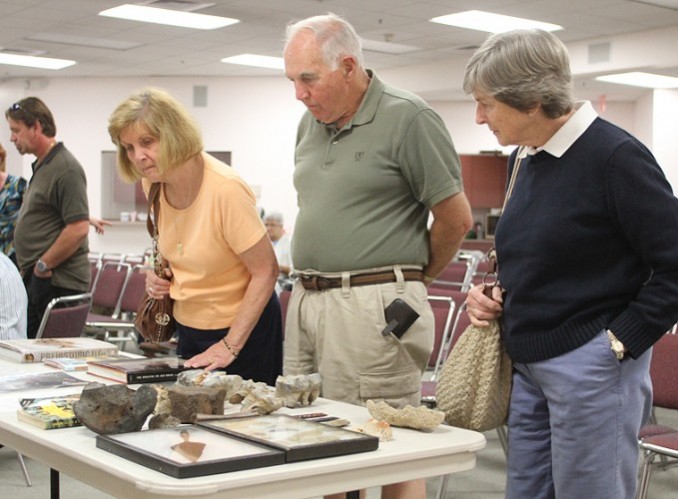SEBASTIAN — They heard that man and beast co-existed in Florida more than 13,000 years ago, that a tidal wave might be to blame for wiping them out at the same time, and that “arrowheads” – as most call them – are no such thing. The revelations washed over the crowd of about 50 people at the North County Library in Sebastian during a lecture on archaeological finds in Indian River County.
“This is just astonishing,” said Daniel Brownhill, who attended the lecture with his wife, Laura.
He said it was hard to fathom that humans came to Florida so long ago.
Speaker Harry Tanner, of the Sebastian Area Historical Society, told the audience Wednesday night that proof exists that man was here at least 13,000 years ago, long before the development of Egypt – 6,000 years ago.
The information caused murmurs to ripple through the audience and more than one head to shake in disbelief.
“That’s the paradigm shift,” Tanner said, noting that scientists have long held that human civilization became established in Mesopotamia – often referred to as the “cradle of civilization” – before human migrated into what is now Europe, Asia and, later North America.
The lecture Wednesday focused mainly on the mammoth etching found on a piece of bone near what is called the “Old Vero Man” site in Vero Beach discovered by local resident James Kennedy.
The bone depicts that of a mammoth in movement “seemingly charging through a village,” said Tanner. Faint etchings of tents are evident on the fossilized bone fragment .
The piece adds to other evidence that man and megafauna – large mammals – co-existed during the Ice Age. Other evidence includes finds of man-made objects embedded in megafauna skulls and other bones from hunts.
Such objects include “points” – what most people have come to call “arrowheads” but were never attached to arrows and shot with bows.
Instead, the points – usually made of stone or animal bone – were attached to some form of handle and used like a knife or spear.
Kennedy answered questions from the audience about his mammoth find, noting that he has had an interest in finding such fossils since he was a child.
“I’m not a scientist,” he said. “I just got lucky one day.”
He later added, “You have no idea what’s underneath your feet out there.”
There are a few theories regarding how it was that both early man and mega-beast disappeared at the same time.
One holds that as the Ice Age continued, fresh water got sucked into the ice sheets that blanketed the northern half of the present day United States of America, leaving no fresh water for animals or humans to consume. Being in Florida, there was nowhere for them to travel.
“This was the end of the line,” Tanner said.
Kennedy has another theory – one that points to a massive tidal wave as the culprit. He explained that, due to gravity and the earth’s rotation, the planet has a bit of wobble at the poles. Eventually, the wobble equalizes, resulting in a possible tidal wave.
Another possible cause of a tidal wave, according to Kennedy, is the shifting of the earth’s tectonic plates, again due to gravity and rotation. The plates shift causing massive ripples in the water that form tidal waves.
Kennedy mentioned an archaeological find in the area of Alaska that contained frozen remains of crocodiles, ostriches, polar bears trees and other animal and plant life all in the same strata. He said something catastrophic would have had to have happened in order for the disparate animals and plants to be found together from the same time.
Jon Cassady, who came to the lecture as a guest of Rex Purcelle, said the tidal wave theory raises questions. One such question was whether carbon dating was being done. Another was how crocodiles and ostriches could end up in the Alaska area.
“It’s fascinating,” Purcelle said of the presented information.

